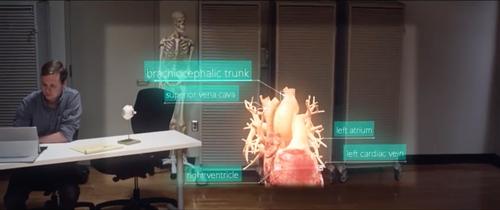
A Microsoft promotional video still that shows the HoloLens's field of view limitations
The early reception for Microsoft's HoloLens augmented reality headgear has been cautiously optimistic, save for one persistent bugbear: the device's field of view. Up until Wednesday, Microsoft hadn't shown that limitation in its promotional videos, but new footage demonstrates what it's like to look through a HoloLens.
In addition to the usual, massive holograms that appear to fill a room, the video shows several renderings of what it's like to look through the HoloLens hardware itself. As the camera pans up and down over models of a human heart and human bones, bits of the holograms are clipped off at the edges of a centered frame that represents the HoloLens's field of view.
The unaugmented space around that frame represents what someone would see in their peripheral vision while wearing the device.
That squares with my experience testing the HoloLens: Microsoft's early demos focused on showing large holograms, but device users often don't get to see the entire picture all at once. At times, the limitation can be profoundly annoying, but in other instances it is hardly noticeable, especially when users are far enough away from a holographic object that it fits inside the HoloLens's viewing window.
After my demo at Microsoft's Build conference in April, HoloLens frontman Alex Kipman said that the field of view limitation was imposed in part so that users could continue to use their peripheral vision without having to see through the holograms displayed by the hardware.
That explanation felt like something of a cop-out, but there are some benefits to still being able to see beyond the space covered by the HoloLens's ... lenses. Namely, it's possible to look around the displayed images at someone who's trying to talk to you.
The news comes a couple days after the company announced it was offering a total of US$500,000 in grants along with HoloLens hardware to researchers who have plans to explore how the device can be put to use.
In addition, Microsoft recently announced a partnership with NASA to develop new software for the device that would provide augmented reality instructions to astronauts aboard the International Space Station.
ISS crew members were supposed to receive a pair of HoloLens units for testing with a set of supplies launched a week and a half ago, but those were lost along with the other cargo inside the SpaceX-built Dragon capsule after the Falcon 9 rocket propelling it away from earth exploded shortly after launch.
Join the CIO Australia group on LinkedIn. The group is open to CIOs, IT Directors, COOs, CTOs and senior IT managers.
